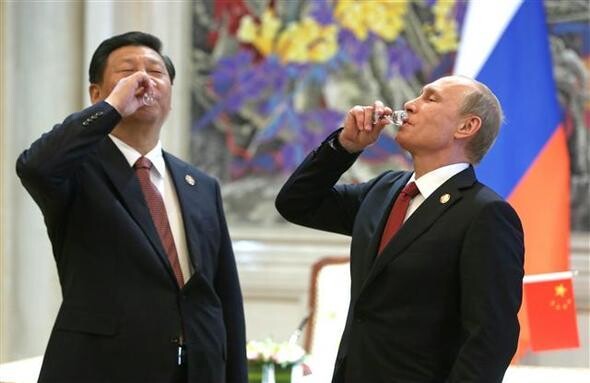hankyoreh
Links to other country sites 다른 나라 사이트 링크
[Analysis] The war without gunfire in the East and South China Seas

By Seong Yeon-cheol, Beijing correspondent
The hottest waters in the world right now are the East and South China Seas. The situation there is one of war without gunfire, as the countries in the region fight fiercely for territory. The flames of long-smoldering conflicts have been fanned by major incidents such as China’s declaration of an Air Defense Identification Zone in the East China Sea in Nov. 2013 and this month’s conflict with Vietnam over oil drilling in the South China Sea. Also, on May 26 there was a collision between a Chinese and a Vietnamese fishing boat in the South China Sea, resulting in the sinking of Vietnamese vessel. The incident led to more back and forth criticism between China and Vietnam. But the real source of the turmoil in these troubled seas is a power battle between the US, long the world’s only superpower, and China, its rising challenger.
■ Spear and shield: China rises, the US parries
As the Barack Obama administration began its second term in the White House, Washington adopted a so-called “rebalancing Asia” policy, putting the East Asian region at the center of its global strategy. The US withdrew from Iraq and Afghanistan and began focusing its strategy on checking China. After completing an April tour of South Korea, Japan, the Philippines, and Malaysia, Obama added to the pressure on China by calling for stronger alliances in the region.
Since Xi Jinping took office as President last year declaring a “great revival of the Chinese people,” the country hasn’t shied away from using its weight against the US, which it has asked to be a partner in a “new type of great power relationship.” In May, it marked a new, cozy relationship with Russia - and possible check against the US - by signing a massive natural gas contract worth some US$400 billion. Experts have called the relationship between the two “the next closest thing to an alliance.” At a recent Conference on Interaction and Confidence Building Measures in Asia (CICA) summit in Shanghai, Xi fired a “hands off” salvo at Washington, announcing, “security issues and other Asian matters should be handled by Asians.” Analysts are noting the change from the foreign policy strategy of the Deng Xiaoping era, encapsulated in the term “tao guang yang hui” (“hiding your abilities and secretly building strength” 韜光養晦), to one of taking the initiative in political matters(主動作爲).
At root, the issue is Washington and Beijing’s lack of trust in each other’s core foreign policy strategies. China’s calls for a “new type of great power relationship” - one of the established superpower and the new superpower respecting each other’s key interests and avoiding friction - are being read by the US as a declaration that Beijing hopes to expand enough to be a rival. China, for its part, sees the “rebalancing Asia” strategy as an attempt to hamstring its own rise. Yan Xuetong, dean of the Institute of Modern International Relations at Tsinghua University and an inveterate realist, summed it up by calling the two countries “fake friends.”

■ China security report: ‘US threat to maritime security’
In China’s eyes, the politics of East Asia, including the East and South China Sea, poses a major threat to its security. Indeed, East Asian conflict was cited alongside terrorism as one of two major threats in a 2014 National Security Report published early this month by the Center for International Strategy and Security Studies, an institution in the Chinese Foreign Ministry’s University of International Relations. Maritime conflicts were the subject of particular concern, with references to “intensifying clashes and conflict” and “mounting potential threats.”
On Japan, the report noted changes since the Prime Minister Shinzo Abe took office. “On the issue of the Diaoyu Islands [called the Senkaku Islands in Japan], they have repudiated the two countries’ established understanding that it should be put off until later, and they have been propagandizing more about the ‘Chinese threat,’ with claims that China is using military force to change the basic order in the East China Sea,” it observed.
It went on to note a bill sponsored by Japan’s Liberal Democratic Party last June for the security and policing of an area 12 nautical miles around the Senkaku Islands, which it called a provocation against China. Abe, who recently toured a number of Southeast Asian countries, was accused of trying to persuade them to “put up a united front against China.”
The report also noted that the Philippines and Vietnam were beefing up their military presence in the South China Sea to counter China. As examples, it pointed to Manila’s 75 billion peso (US$1.7 billion) five-year plan last July to modernize its military equipment, and Hanoi’s decision last year to sign a fighter jet contract with Russia’s Sukhoi company and set up an official naval air unit.
According to the report, the US was behind the moves.
“As the world’s only superpower, the US poses an omnidirectional and direct threat to China’s maritime security,” the report concluded. “As an outside presence, it has increased its involvement and interference in East and South China Sea issues in various ways.”
■ China’s options?
Analysts said China does not appear likely to react too strongly for now in its East Asian disputes - including a possible military response. Indeed, it refrained from throwing its weight around even after two nationals lost their lives in anti-China demonstrations in Vietnam in the wake of its South China Sea oil drilling. Instead, it decided to pull out its citizens, stop tourism efforts, and instill a partial and temporary halt to exchange with Vietnam. In short, it went the route of economic and diplomatic pressure.
Its move followed the playbook outlined in the national security report, which advised “explaining to the US about China’s resolute stance on key interests, while using various means of military exchange and communication to avoid maritime clashes.”
[%%IMAGE3%%]“Japan is attempting to slow the decline of its global prestige by playing up its altercation with China, while in the Philippines and Vietnam, domestic discontent is soaring because of the unfavorable trade balance resulting from free trade agreements signed with China. These countries are attempting to channel that discontent into territorial disputes,” Yan Xuetong said in “Inertia of History (China and World in Future Ten Years).”
“In 2023, ten years from now, when China becomes a superpower to rival the US, these countries will come to terms with reality and will not be as sensitive about maritime disputes as they are at present,” Yan predicts.
But Yan also said, “for the next ten years until that happens, the US and China will engage in fierce competition on a strategic level, sharply driving up military expenditures in the region. It is likely that territorial disputes in East Asia will continue for the time being.”
Please direct questions or comments to [english@hani.co.kr]

Editorial・opinion
![[Column] Has Korea, too, crossed the Rubicon on China? [Column] Has Korea, too, crossed the Rubicon on China?](https://flexible.img.hani.co.kr/flexible/normal/500/300/imgdb/original/2024/0419/9317135153409185.jpg) [Column] Has Korea, too, crossed the Rubicon on China?
[Column] Has Korea, too, crossed the Rubicon on China?![[Correspondent’s column] In Japan’s alliance with US, echoes of its past alliances with UK [Correspondent’s column] In Japan’s alliance with US, echoes of its past alliances with UK](https://flexible.img.hani.co.kr/flexible/normal/500/300/imgdb/original/2024/0419/2317135166563519.jpg) [Correspondent’s column] In Japan’s alliance with US, echoes of its past alliances with UK
[Correspondent’s column] In Japan’s alliance with US, echoes of its past alliances with UK- [Editorial] Does Yoon think the Korean public is wrong?
- [Editorial] As it bolsters its alliance with US, Japan must be accountable for past
- [Guest essay] Amending the Constitution is Yoon’s key to leaving office in public’s good graces
- [Editorial] 10 years on, lessons of Sewol tragedy must never be forgotten
- [Column] A death blow to Korea’s prosecutor politics
- [Correspondent’s column] The US and the end of Japanese pacifism
- [Guest essay] How Korea turned its trainee doctors into monsters
- [Guest essay] As someone who helped forge Seoul-Moscow ties, their status today troubles me
Most viewed articles
- 1[Column] The clock is ticking for Korea’s first lady
- 2[Correspondent’s column] In Japan’s alliance with US, echoes of its past alliances with UK
- 3Samsung barricades office as unionized workers strike for better conditions
- 4After 2 months of delayed, denied medical care, Koreans worry worst may be yet to come
- 5[Column] Has Korea, too, crossed the Rubicon on China?
- 6[Editorial] When the choice is kids or career, Korea will never overcome birth rate woes
- 7Hong Se-hwa, voice for tolerance whose memoir of exile touched a chord, dies at 76
- 8US overtakes China as Korea’s top export market, prompting trade sanction jitters
- 9Constitutional Court rules to disband left-wing Unified Progressive Party
- 10Nearly 1 in 5 N. Korean defectors say they regret coming to S. Korea